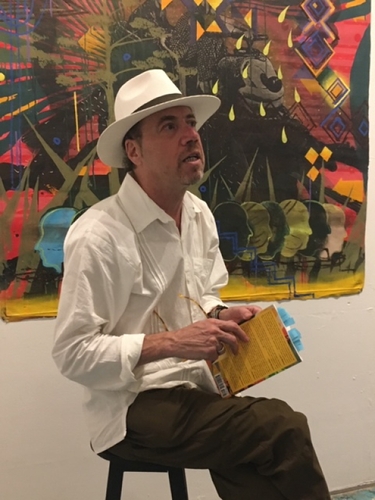PUTNEY — “You never know.”
That was poet Mark Statman's response to the question about when he knows that a collection of work is right or ready, especially relating to his new collection, Exile Home.
Statman is bringing this new collection to Antidote Books on Tuesday, Oct. 29 at 7 p.m., where he will offer one of his last readings on a three-week Northeastern tour.
His response is a nod to all the greatest maxims about the creative process and how the idea of “fit” or “rightness” in terms of the work is all a part of the process itself.
Statman has spent most of his life as poet, teacher, and professor. His professional distinctions have included everything from translating at least three books to becoming the first professor to gain the distinction of emeritus at Eugene Lang College to contributing to The Nation, The Guardian, and The Village Voice as a journalist and cultural critic in the '80s and '90s.
Before calling Mexico home, Statman, a born-and-raised New Yorker, lived in Brooklyn for 31 years.
His first memory of poetry starts where similar memories might start for others - in high school.
But, as Statman tells it, high school does not a poet make because there is a difference between saying that one writes poetry versus claiming the title of poet.
He says he was able to make this transition during his years at Columbia University.
“Kenneth Koch was the first person to take me seriously,” Statman says of the U.S. poet, playwright, and professor “Studying with him was rigorous. This is where I made the transition from 'I write poetry' to 'I am a poet.'”
At Columbia, he also studied with “other great poets” like David Shapiro, he says.
There, during the late 1970s, Statman found himself in a milieu of other amazing young poets, his peers.
* * *
Statman says that his life in South America has removed barriers In a way that has let his work in various literary genres feed into one another. There, poetry, journalism, and cultural criticism flowed with no distinction.
When taking a step back, one might say that the linkages between guiding students, working in journalism, and crafting poetry all have foundations of bearing witness.
Bearing witness is also deeply connected to previous witness bearers - those writers whose poetry and prose are eternally on his nightstand and influence his work.
Of those influences, Statman begins, “There's many.”
In addition to all of his teachers, his range of poetic inspirations include everyone from Robert Creeley to Elizabeth Bishop.
“Currently, I am undergoing an intensive study of modern and contemporary Mexican poets,” he says.“I am always playing around with poetry.”
This constant revision is key to Statman's aesthetic of constantly seeing his work from different angles.
“Even as I read from my collection now, I am changing [the poems],” he says.
* * *
This new collection, Exile Home - his fifth -is in this same spirit of shifting, changing, and playing around with poetry, as Statman describs.
Exile Home grapples with expressing the sense of belonging, the concept of being between and betwixt of the familiarity or what one knows as home and the newness of adjusting to making home in another country. What does one take or choose to leave behind when leaving what is known and familiar?
Crafting spare and economical poetic lines within poems that at times contain one-word titles, Statman expresses his answers to a few of these questions.
The poem “this is not us” is one of many addressing the meaning of between and betwixt - his previous home of Brooklyn, N.Y. and his current home in Mexico - with these lines: “I will always be/from Brooklyn I will/never be Oaxaqueño /but here I am/I think for/the rest of my/life.”
In another poem, “breaking in,” the familiarity of Brooklyn is described from within a dream: “last night/it's dreaming/Brooklyn our/old house/of things left/behind/we needed to throw away/needed to destroy/of ourselves...”
This poem highlights another piece of human complexity that Exile Home unzips - what do we destroy of ourselves when leaving the familiar or when the familiar leaves us? What new self is fashioned out of the gaining and losing of place?
The collection promises to deliver a range of these emotions and complexities of place while bookended by key poems that encompass the grief of loss of a parent and time.
“Green Side Up” opens Exile Home and features stanzas that are shapshots of memory across the range of Statman's life as the poem illustrates him attempting to face the death of his father.
The collection closes with “a history of snow,” a poem that embodies the specific imagery and memory of a place and landscape once known.
In his previous collections - That Train Again (2015) and A Map of the Winds (2013) - Statman curated work that was three to five years old.
With Exile Home, the nature of the collection has changed, mirroring the changes in his own life.
As he arrived in Mexico in 2016, he had an epiphany, “I realized that I was different,” he recalls. “The work I was going to include no longer fit. I was still in the process of becoming.”
When asked about the decision to connect “exile” and “home” within the title, Statman simply responded, “It's a statement.”
More than a statement, his gift is taking the complexity of human emotion and craft and architecting deceivingly simple lines.
But this is all a part of the magic of his work.
As Statman would say, “That is a part of the complication. To make the complicated seem simple.”
